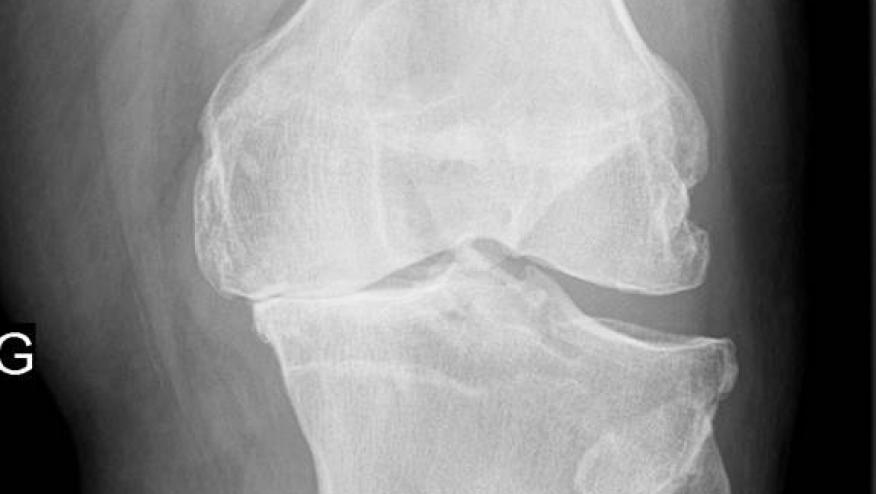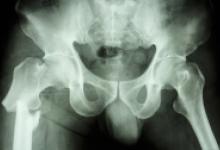IL-1 Blockade: A Treatment at Last for Osteoarthritis? Save

The interleukin (IL)-1β inhibitor canakinumab (Ilaris) showed promise for preventing the need for hip or knee replacement among patients with osteoarthritis in an exploratory analysis of data from a randomized clinical trial, investigators reported.
Among patients enrolled in the Canakinumab Anti-Inflammatory Thrombosis Outcomes Study (CANTOS), the pooled incidence rate for total hip replacement/total knee replacement (THR/TKR) was 0.31 events per 100 person-years for those receiving the monoclonal antibody every 3 months for up to 5 years compared with 0.54 per 100 for those given placebo, according to Paul M. Ridker, MD, of Harvard Medical School in Boston, and colleagues.
Accordingly, the hazard ratio for THR/TKR with canakinumab treatment was 0.58 (95% CI 0.42-0.80, P=0.001), the researchers reported in Annals of Internal Medicine.
"The results of this exploratory trial are both unexpected and exciting," stated Nancy Lane, MD, of University of California Davis Health, and David Felson, MD, of Boston University School of Medicine, in an editorial accompanying the study.
With the aging of the population, the prevalence of osteoarthritis has been on the rise in recent decades, but effective treatments have remained elusive.
The chronic joint inflammation associated with osteoarthritis typically is characterized by the presence of inflammatory mediators, including IL-1β, which can drive cartilage destruction through release of proteolytic enzymes. Whether targeting this cytokine could provide benefits in osteoarthritis has not been determined. Previous studies examining this possibility have been limited by short duration and a focus primarily on pain, and found no significant improvements.
To more fully explore the possibility that canakinumab might have structural-modifying rather than analgesic effects in osteoarthritis, Ridker and colleagues analyzed data from CANTOS, which included 10,061 patients with a history of myocardial infarction and elevated C-reactive protein (CRP), randomizing them to canakinumab in dosages of 50, 150, or 300 mg or placebo every 3 months. The study took place from 2011 to 2017 in 39 countries, and was sponsored by Novartis.
In the study's main analysis, patients receiving the active treatment had fewer cardiovascular events but more serious infections and infection-related mortality. Canakinumab has therefore not been recommended for the secondary prevention of heart disease.
However, THR/TKR was considered a serious adverse event and was routinely reported, providing a large, long-term source of data on the effects of canakinumab on the most severe cases of osteoarthritis.
During a median follow-up of 3.7 years, the hazard ratios for THR/TKR compared with placebo for all three dose groups were reduced:
- 50 mg, HR 0.60 (95% CI 0.38-0.95)
- 150 mg, HR 0.53 (95% CI 0.33-0.84)
- 300 mg, HR 0.60 (95% CI 0.38-0.93)
Risks for THR/TKR also were reduced for both men (HR 0.54, 95% CI 0.36-0.81) and women (HR 0.66, 95% CI 0.38-1.12), the researchers reported.
In a subgroup analysis that excluded patients with gout or rheumatoid arthritis, similar significantly lower risks were again seen, and in a secondary analysis evaluating the effects of treatment on new or worsening arthritis symptoms, the incidence rates were 1.17 per 100 person-years in the pooled canakinumab groups compared with 1.63 per 100 in the placebo group (HR 0.73, 95% CI 0.61-0.87).
"These data thus provide support for the hypothesis that IL-1β inhibition might represent a novel pathway for future therapies targeting osteoarthritis," Ridker and colleagues stated.
The finding that risk reductions were similar in the three dose groups suggests that the lower doses could provide similar efficacy while possibly minimizing risks, the researchers noted.
Limitations of the study, they said, included that CANTOS was not intended to evaluate canakinumab for osteoarthritis, so data on many aspects of the disease such as functional status and radiographic progression were not routinely collected. In addition, the number of women included was relatively small (approximately 25%), whereas knee osteoarthritis primarily afflicts older women.
In their editorial, Lane and Felson wrote, "Further studies should evaluate the importance of elevated CRP levels as a factor affecting response to treatment, include more women to better reflect the osteoarthritis population, explore how to minimize infections, and try to better define the duration of therapy needed to detect treatment effects."
Disclosures
CANTOS was sponsored by Novartis.
Schieker M, et al "Effects of interleukin-1β on incident hip and knee replacement: exploratory analyses from a randomized, double-blind, placebo-controlled trial" Ann Intern Med 2020; doi:10.7326/M20-0527.







If you are a health practitioner, you may Login/Register to comment.
Due to the nature of these comment forums, only health practitioners are allowed to comment at this time.